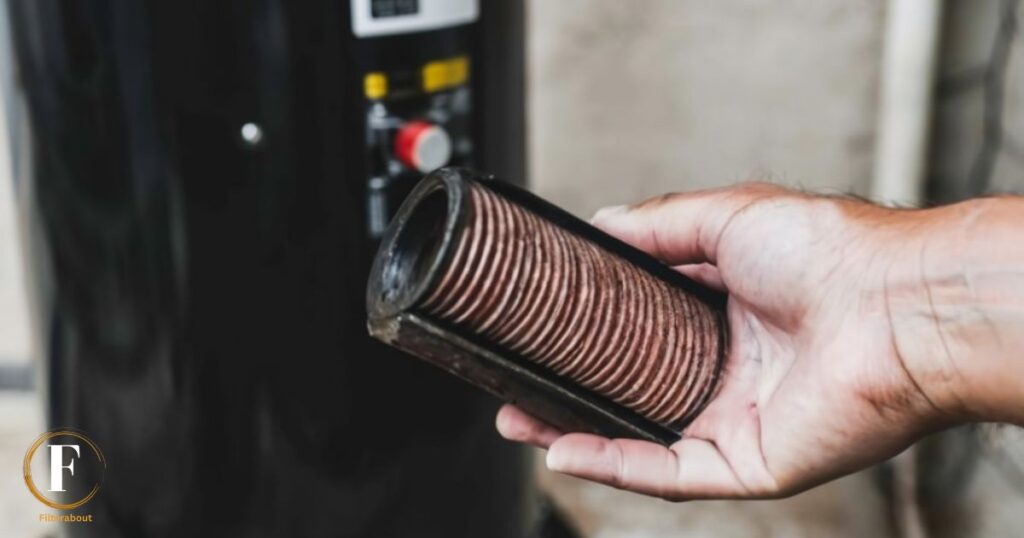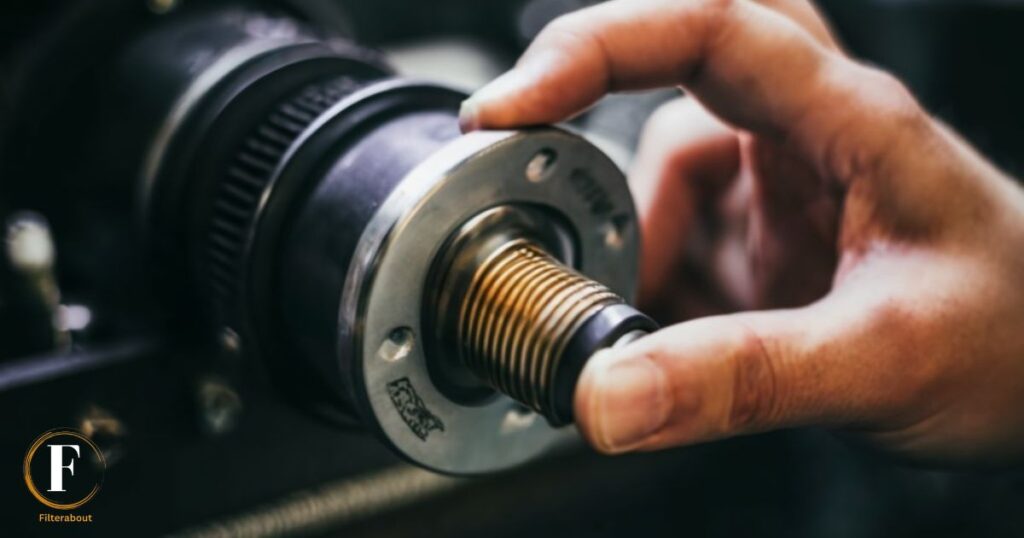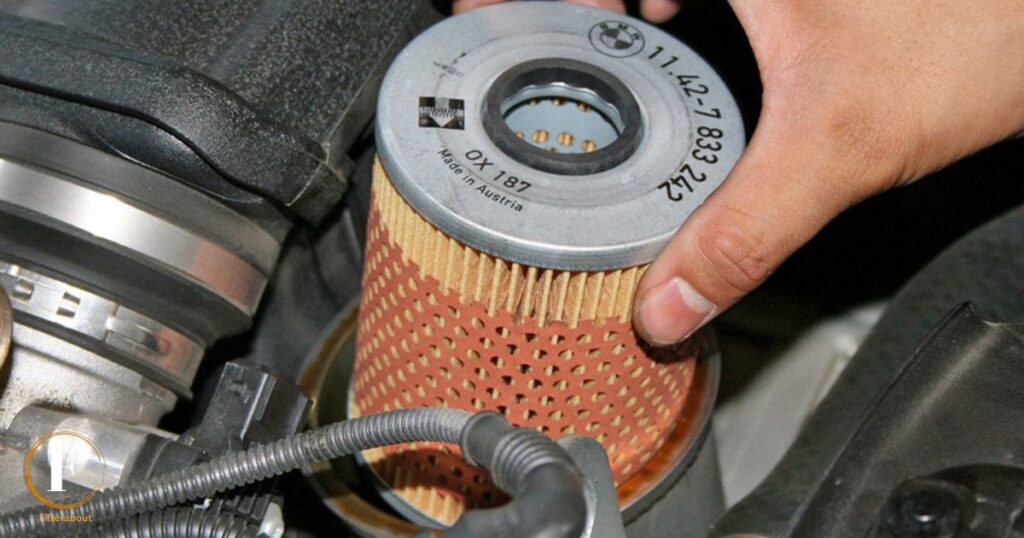An outside oil tank is a container placed outdoors to store oil for heating purposes in homes or businesses. It’s typically made of steel or plastic and can hold varying oil capacities depending on the size. These tanks are connected to heating systems to supply fuel for warmth during colder months.
Maintaining your outside oil tank’s filter is pivotal for its longevity. Our guide How to Clean a Filter on an Outside Oil Tank? Offers a detailed, six-step approach. From locating the filter to thorough cleaning techniques, this guide ensures a smooth process. Keep your system running efficiently by following these instructions, preventing potential issues, and ensuring consistent oil flow throughout the year.
Identify the filter housing on your outdoor oil tank. Carefully open the housing using the appropriate tools. Remove the filter and either clean or replace it as needed. Ensure no debris is left behind before securely closing the housing. Regular maintenance keeps your oil tank running smoothly.
Understanding the Importance of a Clean Oil Tank Filter
The outside oil tank filter is crucial for the smooth operation of machinery and vehicles reliant on oil systems. The filter acts as a barrier trapping contaminants like dirt debris and sludge that could otherwise compromise the quality of the oil. Over time these particles accumulate and can obstruct the flow of oil leading to reduced efficiency and potential damage to the equipment.
Regularly cleaning or replacing the outside oil tank filter prevents these contaminants from circulating through the system ensuring that the oil remains clean and free of impurities.
A clean filter allows for proper oil flow which helps preserve the machinery’s optimal performance prolonging its lifespan and minimizing the risk of breakdowns or costly repairs. Maintaining a clean outside oil tank filter not only safeguards the equipment but also contributes to its efficient and reliable functioning.
Neglecting the cleanliness of the oil tank filter can result in decreased efficiency increased wear and tear on machinery and potential system failures.
Therefore it’s essential to adhere to a maintenance schedule that includes inspecting and cleaning or replacing the filter as recommended by the manufacturer. By prioritizing the upkeep of the outside oil tank filter one can ensure the longevity and effectiveness of the machinery or vehicle reliant on oil systems.
Why You Should Clean Your Oil Tank Filter Regularly

Regular cleaning of your outside oil tank filter is crucial for maintaining the efficiency and longevity of your heating system. The filter prevents impurities, sludge, and debris from entering the furnace or boiler ensuring smooth operation.
Over time these contaminants can accumulate clogging the filter and reducing fuel flow. A dirty filter can strain your heating system causing it to work harder consume more energy, and potentially lead to malfunctions or breakdowns.
Cleaning the outside oil tank filter regularly helps to sustain the efficiency of your heating system. A clogged filter obstructs the flow of oil forcing the furnace or boiler to struggle which can decrease its efficiency.
When the system operates inefficiently it not only consumes more fuel but also generates higher energy bills. By routinely cleaning the outside oil tank filter you ensure proper fuel flow allowing your heating system to work optimally and saving both energy and money in the long run.
Moreover, regular maintenance including cleaning the oil tank filter can extend the lifespan of your heating equipment. Clean filters reduce strain on the system preventing premature wear and tear.
To ensure the smooth and efficient operation of your heating system for years to come it is crucial to perform routine maintenance tasks. One such important task is to change oil filter regularly.
By avoiding unnecessary stress on the furnace or boiler you decrease the likelihood of expensive repairs or the need for early replacements. Consistent filter cleaning is a vital aspect of routine maintenance and contributes to the overall health and longevity of your heating system.
Oil Tank Filter Leaking
Sure here’s a simple table outlining 8 steps to address an oil tank filter leaking issue.
| Step | Action |
| 1 | Identify the location of the leak. |
| 2 | Turn off the oil supply to prevent further leakage. |
| 3 | Clean the area around the filter to assess the extent of the damage. |
| 4 | Check the filter for cracks or loose connections. |
| 5 | Tighten any loose fittings or replace damaged parts. |
| 6 | Use a suitable sealant to mend minor cracks if applicable. |
| 7 | Restore the oil supply and monitor for leaks. |
| 8 | Seek professional help if the issue persists or for major repairs. |
Turn Off the Oil Supply

Turning off the oil supply refers to the deliberate cessation or reduction of oil production or distribution which can have significant economic environmental, and geopolitical implications. Oil serves as a primary energy source for transportation, heating, and various industries globally.
Shutting down or reducing oil supply can occur due to geopolitical conflicts economic sanctions, or shifts towards renewable energy sources.
When countries or organizations decide to turn off the oil supply it can lead to immediate consequences. Economically it can cause fluctuations in oil prices impacting fuel costs for transportation and heating.
Countries heavily reliant on oil exports may experience financial strain while oil-importing nations could face supply shortages and increased costs potentially affecting industries and consumers.
A decrease in oil supply might temporarily reduce carbon emissions offering environmental benefits by encouraging the use of alternative cleaner energy sources.
However sudden disruptions in oil supply could also lead to short-term instability affecting the global economy and causing political tensions. Balancing the transition away from oil while ensuring stable energy access remains a complex challenge for both nations and global industries.
Oil Tank Filter Replacement
Oil tank filter replacement is a crucial maintenance task for homes and businesses relying on oil heating systems. The outside oil tank filter plays a vital role in preventing debris sludge and impurities from entering the heating system and causing damage. Over time these filters can become clogged reducing the efficiency of the heating system and potentially leading to malfunctions.
To replace an outside oil tank filter start by turning off the heating system and ensuring the oil tank valve is closed. Locate the filter housing which is typically situated near the oil tank or burner. Use a wrench to carefully remove the old filter and dispose of it properly.
Before installing the new filter, apply a small amount of oil to the rubber gasket to create a proper seal. Secure the new filter in place making sure it is tightened appropriately. Finally, open the oil tank valve restart the heating system, and check for any leaks.
Regular oil tank filter replacement is essential for maintaining the efficiency and longevity of your heating system. It is recommended to replace the filter at least once a year, or more frequently if you notice reduced heating performance or increased fuel consumption.
By performing this simple maintenance task you can ensure that your oil heating system operates smoothly and effectively providing reliable warmth during the colder months.
Safety Gloves
Safety gloves are crucial protective gear shielding hands from potential hazards like chemical cuts or heat. Crafted from durable materials these gloves offer a secure grip while ensuring safety in various work environments. Their versatility makes them indispensable for safeguarding hands during tasks that pose risks of injury or contamination.
Safety Goggles
Safety goggles are essential protective gear for safeguarding the eyes in various environments. They shield against debris, chemicals, and other potential eye hazards ensuring clear vision and safety for the wearer. Designed with durable materials they offer a reliable defense without compromising comfort.
Wrench or Pliers
Choosing between a wrench and pliers often depends on the task at hand. Wrenches are ideal for turning nuts and bolts providing a sturdy grip and torque.
Pliers with their adjustable jaws offer versatility for gripping twisting and cutting wires or smaller objects. Each tool serves distinct purposes with wrenches excelling in solid rotational force and pliers offering a more adaptable fine-grasping capability.
Loosen the Filter Housing

Certainly here are seven steps to loosen the filter housing:
- Turn off Power: Before any maintenance ensure the power to the system is switched off to prevent any electrical hazards or sudden activation during the process.
- Locate the Housing: Identify the housing unit that encases the filter. It usually has screws latches or a specific locking mechanism holding it in place.
- Prepare Tools: Gather the necessary tools like a screwdriver wrench or any specialized tool required to safely loosen the housing.
- Loosen Fasteners: Carefully and steadily use the appropriate tool to loosen the screws or release the latch that secures the housing. Avoid excessive force to prevent damage.
- Remove the Housing Cover: Once the fasteners are loosened gently remove the cover or the housing itself exposing the filter inside.
- Handle with Care: Take care not to disturb the filter unnecessarily. If replacing, note its position and orientation before removing.
- Secure After Maintenance: After completing the necessary maintenance on the filter, reposition the housing cover correctly and securely fasten the screws or locking mechanism. Ensure a tight seal to prevent any leaks.
Remember following the manufacturer’s guidelines specific to your system is crucial to safely and effectively loosen and re-secure the filter housing.
Remove the Filter
It is a metaphorical concept urging individuals to eliminate their mental barriers and preconceived notions when perceiving information or situations. It encourages people to approach things with an open mind free from biases or preconceptions that might limit their understanding or hinder their ability to see the full picture.
This notion is particularly relevant in communication and decision-making emphasizing the importance of acknowledging and discarding personal filters such as biases prejudices or rigid beliefs. By consciously removing these filters, individuals can better comprehend different perspectives make more informed judgments, and foster clearer, more effective communication with others.
It invites a mindset of receptiveness and adaptability enabling individuals to embrace diverse viewpoints, empathize with others’ experiences, and engage more meaningfully with the world around them. It empowers people to break free from narrow thinking patterns and promotes a more inclusive understanding approach to interactions and decision-making.
Inspect the Housing

Inspecting the housing of a property involves a thorough examination of its structural integrity and overall condition. This inspection typically encompasses various key areas such as the foundation walls roof plumbing, electrical systems, and HVAC (heating, ventilation, and air conditioning).
The foundation is crucial inspectors look for cracks shifts or signs of water damage that might compromise the stability of the building. Walls are examined for cracks mold or indications of structural issues. The roof inspection involves checking for leaks missing shingles or any damage that could lead to water penetration.
Inspectors also evaluate plumbing systems checking for leaks water pressure and proper drainage. Electrical inspections involve examining wiring outlets and the main electrical panel for safety and HVAC systems are assessed for proper operation and maintenance.
An inspection report outlines the findings highlighting any issues or areas that need attention. This inspection is vital for potential buyers or property owners to make informed decisions about the property’s condition and potential maintenance or repair needs.
Place the Cleaned or New Filter Back Into the Housing
After cleaning or replacing a filter placing it back into its housing is the final step in ensuring the proper functionality of various systems like air conditioners furnaces or even some water filtration setups. First, ensure that the filter is completely dry if it is washed or cleaned. Moisture can lead to mold growth or reduced efficiency. If it’s a new filter ensure it’s the correct size and type recommended for your system.
Next, locate the housing unit where the filter goes. There’s usually an arrow or indication showing the airflow direction on the filter align this with the corresponding arrow or marking inside the housing. Carefully slide the filter back into place making sure it fits snugly and securely. Check for any gaps or loose edges that might allow unfiltered air or contaminants to bypass the filter.
Once the filter is properly seated secure the housing cover or door ensuring it’s tightly closed. This prevents air from bypassing the filter and maintains proper airflow through the system. Regularly checking and replacing or cleaning filters can significantly improve air quality and system efficiency while extending the lifespan of your equipment.
Proper Installation Procedure
Ensure a successful filter replacement by following these steps Place the Cleaned or New Filter Back into the Housing. This crucial step in your maintenance routine guarantees optimal performance and longevity for your equipment.
Maintaining Equipment Efficiency
Discover the key to sustaining your equipment’s efficiency by mastering the art of placing a cleaned or new filter into its housing. This step-by-step guide ensures that your system operates at peak performance promoting a healthy and clean environment.
Essential Filter Housing Integration
Uncover the significance of seamlessly integrating your cleaned or new filter back into its housing. Learn the best practices and tips for this critical task to maximize the effectiveness of your filtration system and maintain a cleaner healthier space.
Frequently Asked Questions
Can you clean an oil filter and use it again?
Cleaning an oil filter is not recommended as it compromises filtration. Reusing it might affect engine performance and durability. It’s discouraged.
Can an oil filter last 2 years?
Oil filters are generally designed to be replaced during regular oil changes every 3,000 to 10,000 miles, not lasting 2 years.
Does oil filter last longer than oil?
Oil filters don’t last as long as oil. Filters are usually replaced during oil changes, while oil can last several thousand miles.
What are the symptoms of an old oil filter?
Signs of a worn-out oil filter include decreased oil pressure, dirty or contaminated oil, engine knocking, or a check engine light.
Conclusion
Cleaning the filter on an outside oil tank is a crucial maintenance task that ensures the smooth functioning of your heating system. How to Clean a Filter on an Outside Oil Tank? To conclude, this process, though seemingly simple demands precision and care. It’s essential to turn off the oil supply and power to the system before starting. Begin by identifying the filter location and carefully removing it taking note of any leaks or damages.
Thoroughly clean the filter by using appropriate tools and cleaning agents to remove accumulated debris, dirt or sediment. Inspect the filter for any signs of wear or tear replacing it if necessary. After cleaning, reinstall the filter securely ensuring proper sealing and connections to prevent leaks. Finally, restore the oil supply and power checking for any irregularities or leaks before fully operating the system.
Regularly scheduled filter maintenance helps maintain the efficiency of your heating system prevents clogs and prolongs its lifespan. By following these steps diligently you ensure a clean filter and efficient functioning of your outside oil tank system, providing consistent warmth and comfort while prolonging its longevity.

Alexander Quinn is the author behind Filterabout.com. Known for expertise in diverse topics, Quinn’s content on the website reflects a versatile knowledge base catering to various interests.



![Jynxzi Age, Net Worth, Career[2024]](https://filterabout.com/wp-content/uploads/2024/05/Who-Is-Shanin-Blake-Age-Wiki-Parents-Dating-Net-Worth-300x148.jpg)
![Jynxzi Age, Net Worth, Career[2024]](https://filterabout.com/wp-content/uploads/2024/05/Jynxzi-Age-Net-Worth-Career2024-300x148.jpg)


![Kutty Surumi Net Worth, Bio, Age[2024]](https://filterabout.com/wp-content/uploads/2024/05/Kutty-Surumi-Net-Worth-Bio-Age2024-300x148.jpg)



![Jynxzi Age, Net Worth, Career[2024]](https://filterabout.com/wp-content/uploads/2024/05/Who-Is-Shanin-Blake-Age-Wiki-Parents-Dating-Net-Worth-150x150.jpg)